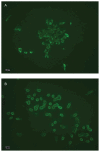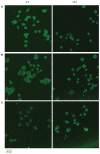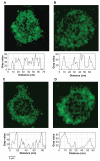Surface engineering of macrophages with nanoparticles to generate a cell-nanoparticle hybrid vehicle for hypoxia-targeted drug delivery
- PMID: 20161985
- PMCID: PMC2819902
Surface engineering of macrophages with nanoparticles to generate a cell-nanoparticle hybrid vehicle for hypoxia-targeted drug delivery
Abstract
Tumors frequently contain hypoxic regions that result from a shortage of oxygen due to poorly organized tumor vasculature. Cancer cells in these areas are resistant to radiation- and chemotherapy, limiting the treatment efficacy. Macrophages have inherent hypoxia-targeting ability and hold great advantages for targeted delivery of anticancer therapeutics to cancer cells in hypoxic areas. However, most anticancer drugs cannot be directly loaded into macrophages because of their toxicity. In this work, we designed a novel drug delivery vehicle by hybridizing macrophages with nanoparticles through cell surface modification. Nanoparticles immobilized on the cell surface provide numerous new sites for anticancer drug loading, hence potentially minimizing the toxic effect of anticancer drugs on the viability and hypoxia-targeting ability of the macrophage vehicles. In particular, quantum dots and 5-(aminoacetamido) fluorescein-labeled polyamidoamine dendrimer G4.5, both of which were coated with amine-derivatized polyethylene glycol, were immobilized to the sodium periodate-treated surface of RAW264.7 macrophages through a transient Schiff base linkage. Further, a reducing agent, sodium cyanoborohydride, was applied to reduce Schiff bases to stable secondary amine linkages. The distribution of nanoparticles on the cell surface was confirmed by fluorescence imaging, and it was found to be dependent on the stability of the linkages coupling nanoparticles to the cell surface.
Keywords: anticancer drug; cellular vehicle; confocal microscopy; dendrimer; drug delivery; hypoxia; nanotechnology.
Figures








Similar articles
-
Dual-Ligand Modified Polymer-Lipid Hybrid Nanoparticles for Docetaxel Targeting Delivery to Her2/neu Overexpressed Human Breast Cancer Cells.J Biomed Nanotechnol. 2015 Aug;11(8):1401-17. doi: 10.1166/jbn.2015.2086. J Biomed Nanotechnol. 2015. PMID: 26295141
-
Tumortropic monocyte-mediated delivery of echogenic polymer bubbles and therapeutic vesicles for chemotherapy of tumor hypoxia.Biomaterials. 2015 Dec;71:71-83. doi: 10.1016/j.biomaterials.2015.08.033. Epub 2015 Aug 19. Biomaterials. 2015. PMID: 26318818
-
Biodegradable MnFe-hydroxide nanocapsules to enable multi-therapeutics delivery and hypoxia-modulated tumor treatment.J Mater Chem B. 2020 May 6;8(17):3929-3938. doi: 10.1039/d0tb00243g. J Mater Chem B. 2020. PMID: 32232281
-
Advanced targeted therapies in cancer: Drug nanocarriers, the future of chemotherapy.Eur J Pharm Biopharm. 2015 Jun;93:52-79. doi: 10.1016/j.ejpb.2015.03.018. Epub 2015 Mar 23. Eur J Pharm Biopharm. 2015. PMID: 25813885 Review.
-
Lipid-enveloped hybrid nanoparticles for drug delivery.Nanoscale. 2013 Feb 7;5(3):860-72. doi: 10.1039/c2nr32880a. Epub 2013 Jan 4. Nanoscale. 2013. PMID: 23292080 Review.
Cited by
-
Cell Surface Engineering Tools for Programming Living Assemblies.Adv Sci (Weinh). 2023 Dec;10(34):e2304040. doi: 10.1002/advs.202304040. Epub 2023 Oct 12. Adv Sci (Weinh). 2023. PMID: 37823678 Free PMC article. Review.
-
Click hybridization of immune cells and polyamidoamine dendrimers.Adv Healthc Mater. 2014 Sep;3(9):1430-8. doi: 10.1002/adhm.201300515. Epub 2014 Feb 13. Adv Healthc Mater. 2014. PMID: 24574321 Free PMC article.
-
Harnessing Macrophages for Controlled-Release Drug Delivery: Lessons From Microbes.Front Pharmacol. 2019 Jan 25;10:22. doi: 10.3389/fphar.2019.00022. eCollection 2019. Front Pharmacol. 2019. PMID: 30740053 Free PMC article. Review.
-
Cell-mediated nanoparticle delivery systems: towards precision nanomedicine.Drug Deliv Transl Res. 2024 Nov;14(11):3032-3054. doi: 10.1007/s13346-024-01591-0. Epub 2024 Apr 13. Drug Deliv Transl Res. 2024. PMID: 38615157 Free PMC article. Review.
-
Biomimetic Systems Involving Macrophages and Their Potential for Targeted Drug Delivery.Biomimetics (Basel). 2023 Nov 12;8(7):543. doi: 10.3390/biomimetics8070543. Biomimetics (Basel). 2023. PMID: 37999184 Free PMC article. Review.
References
-
- Gahmberg CG, Tolvanen M. Nonmetabolic radiolabeling and tagging of glycoconjugates. Methods Enzymol. 1994;230:32–44. - PubMed
-
- Mahal LK, Yarema KJ, Bertozzi CR. Engineering chemical reactivity on cell surfaces through oligosaccharide biosynthesis. Science. 1997;276(5315):1125–1128. - PubMed
-
- Kellam B, De Bank PA, Shakesheff KM. Chemical modification of mammalian cell surfaces. Chem Soc Rev. 2003;32(6):327–337. - PubMed
-
- Premkumar DR, Fukuoka Y, Sevlever D, et al. Properties of exogenously added GPI-anchored proteins following their incorporation into cells. J Cell Biochem. 2001;82(2):234–245. - PubMed
-
- Hussey SL, He E, Peterson BR. A synthetic membrane-anchored antigen efficiently promotes uptake of antifluorescein antibodies and associated protein a by mammalian cells. J Am Chem Soc. 2001;123(50):12712–12713. - PubMed
Publication types
MeSH terms
Substances
Grants and funding
LinkOut - more resources
Full Text Sources
Other Literature Sources

